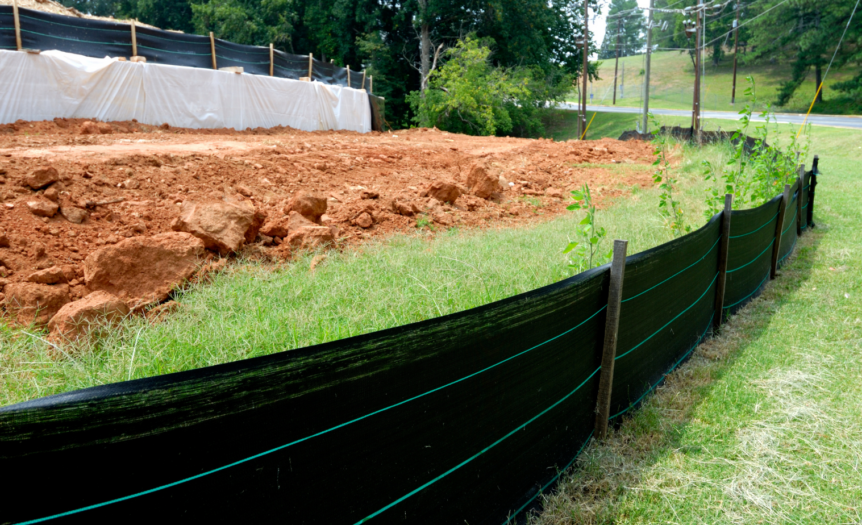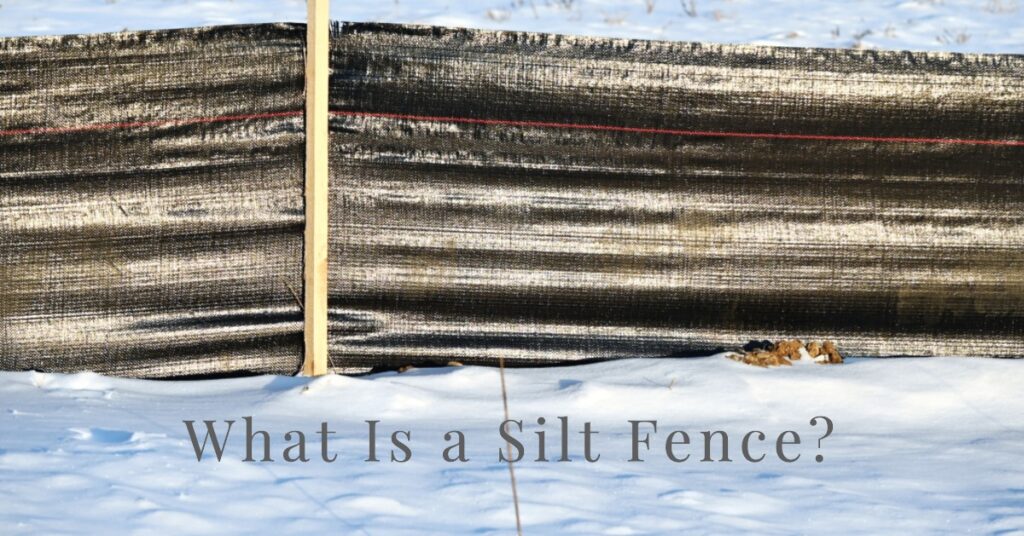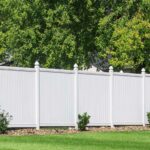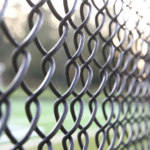In the world of construction and landscaping, protecting our environment is more important than ever. A key component to achieving this goal is understanding effective methods for managing soil erosion and sediment control, like using a silt fence on your project site.
But what exactly is a silt fence, and how does it work? In simple terms, a silt fence is an essential tool designed to prevent contaminated stormwater runoff from negatively impacting nearby water bodies.
This versatile barrier can be found in various settings ranging from construction sites to agricultural areas, promoting environmental protection while meeting industry regulations.
What Is A Silt Fence?
A silt fence is a barrier made of filter fabric that is designed to prevent sediment and construction debris from washing off a site and into nearby bodies of water.
Definition And Purpose
A silt fence, often referred to as a “filter fence,” is a temporary sediment control device designed to prevent soil erosion and protect water quality on construction sites.
It serves as a barrier between disturbed soil and nearby bodies of water, capturing sediment-laden stormwater runoff while allowing clean water to pass through.
The effectiveness of a silt fence lies in its carefully chosen materials and design – typically consisting of a woven geotextile fabric anchored into the ground with wood or metal stakes.
This barrier not only captures fine particles like silt but also larger debris from construction activities. For instance, during land grading or excavation projects, these fences minimize the migration of sediment offsite and mitigate damage to neighboring properties or natural environments.
Materials Used
Silt fences are made up of a thick filter fabric material, typically made from woven or non-woven geotextile. The fabric is designed to allow water to pass through while trapping sediment and debris.
Additionally, silt fences require anchoring posts that are often driven into the ground for support. These posts can be made of wood, plastic, or metal depending on the specific application and environmental conditions.
The type of geotextile used in a silt fence can vary based on factors such as soil type and flow rates. Woven fabrics have higher strength properties but may not trap finer sediments as effectively compared to non-woven materials which tend to clog over time when exposed to high levels of runoff flow during heavy rainfall events.
Design And Installation
Silt fences are designed to prevent sediment movement from construction sites, landscaping projects, and other disturbances. The fence is installed by digging a trench around the perimeter of the site and securing filter fabric in place with posts or stakes.
Geotextile fabrics like polypropylene or polyester are typically used because they allow water to flow through while trapping sediment in place.
Proper installation requires careful planning and preparation of the site, including grading and surface stabilization. Posts must be anchored firmly into the ground so that high winds do not compromise their integrity.
In addition, it is essential to maintain silt fences properly by inspecting them regularly for damage or clogging and taking appropriate corrective action if necessary.
Types Of Silt Fences
There are several types of silt fences available on the market, each designed to address specific needs and conditions. One popular type is a wire-backed silt fence, which uses a mesh fabric attached to a wire frame for added strength and stability.
Another option is the staked silt fence, which uses wooden or plastic stakes to anchor the fabric in place. High-flow silt fences are specifically designed for areas with fast-moving water or heavy rain events.
Additionally, some manufacturers offer biodegradable silt fences made of organic materials that break down over time and eliminate the need for disposal.
Benefits Of Using A Silt Fence
Using a silt fence can prevent soil erosion, protect water quality, meet environmental regulations, and provide a cost-effective solution that is both reusable and temporary.
Preventing Soil Erosion
Silt fences are designed to help prevent soil erosion by trapping sediment and debris before they can be carried away by stormwater runoff. These temporary barriers work by acting as a filter, allowing water to pass through but capturing any sediment that may be present.
Silt fences are particularly effective in areas with steep slopes or heavy rainfalls since these conditions increase the risk of erosion. Additionally, their affordability and ease of installation make them a popular choice for many construction projects seeking to meet environmental regulations and best management practices (BMPs) for controlling sedimentation and drainage.
Protecting Water Quality
One of the main benefits of using a silt fence is its ability to protect water quality. When it rains, stormwater runoff can carry sediment, debris, and other pollutants into nearby streams, lakes, and rivers.
This can lead to contamination and harm aquatic life.
For example, imagine a construction site on the bank of a river. Without proper sediment control measures in place such as a silt fence, rainwater could wash away dirt and debris from the site into the river below.
This would not only harm aquatic life but also affect downstream communities that rely on that body of water for drinking water or recreational activities.
Meeting Environmental Regulations
Silt fences are an essential tool for meeting environmental regulations in construction and other projects. Regulations vary by location, but all aim to protect surrounding waterways from sediment runoff that can harm wildlife and habitats.
For example, the United States Environmental Protection Agency (EPA) requires that silt fences be installed at all construction sites where soil may be disturbed or exposed.
By using a silt fence, project managers ensure compliance with these regulations while also protecting the environment. This cost-effective solution helps prevent erosion and sediment buildup, limiting damage to ecosystems downstream.
In conclusion, meeting environmental regulations is crucial when managing construction sites or other activities that impact nearby water sources. Silt fences offer a reliable approach to this challenge by controlling soil erosion and sedimentation while remaining compliant with local laws governing land development practices.
Cost-Effective Solution
Another benefit of using a silt fence is its cost-effectiveness. Compared to other sediment control solutions, such as retaining ponds or sediment basins, silt fences are a more affordable option.
They do not require extensive excavation and can be installed quickly and easily. Additionally, because they are made from geotextile fabric and anchored by posts, they can be reused multiple times if properly maintained.
This temporary barrier does not only provide erosion prevention but also monetary savings for the construction site management team.
Reusable And Temporary
Silt fences are an affordable and convenient solution for sediment control on construction sites, and one of the significant benefits is that they are reusable and temporary.
Unlike permanent structures that need to be built from scratch each time there is a new project, silt fences can be installed quickly when needed and removed once their purpose has been served.
They’re typically made from durable materials like geotextile fabric, which can be stored after use to protect it from damage or wear.
In addition, their temporary nature makes them cost-effective in comparison to permanent soil erosion solutions. By using a silt fence instead of more expensive options such as retaining walls or concrete barriers, businesses can save money without sacrificing environmental protection.
Another advantage of this feature is that it allows developers with limited budgets or tight deadlines to comply with environmental regulations while still completing projects efficiently.
Proper Installation And Maintenance Of Silt Fences
To ensure the effectiveness of a silt fence, it is crucial to properly install and maintain it by preparing the site, using appropriate techniques for installation and regular maintenance, and disposing of used fences correctly; read on to learn more about these important steps.
Site Preparation
Proper site preparation is essential for the effective installation of a silt fence. This includes clearing and leveling the area where the fence will be installed, ensuring any rocks or debris are removed from the soil.
It’s important to ensure that there are no gaps in the soil where water could seep through and cause erosion.
The trench should be deep enough so that when installed, one-third of the height of the fabric extends below ground level while two-thirds extend above it. The fabric can then be unrolled along with posts anchored at regular intervals into place and backfilled to provide additional support.
Installation Techniques
Proper installation is key to the effectiveness of a silt fence. The first step in installing a silt fence is site preparation, which involves clearing debris and ensuring that the ground is level.
Then, posts are driven into the ground at regular intervals along the desired perimeter using an anchoring tool.
It is important to ensure tight contact between the soil and filter fabric all along the length of the silt fence as any gaps may allow contaminated water to flow around or under it.
Regular maintenance including proper disposal of used fencing contributes significantly towards maintaining their efficiency and maximizing their life span.
Regular Maintenance
Silt fences require regular maintenance to ensure their effectiveness in sediment control. Regular inspection of the fence is necessary to check for any damage or tears that may have occurred, as even a small breach in the fabric can render it ineffective.
In addition, accumulated sediment must be removed from both sides of the silt fence periodically. This can be done manually or with specialized equipment such as vacuum trucks.
Proper maintenance ensures that silt fences continue to protect water quality by preventing soil erosion and controlling stormwater runoff effectively.
Disposal Of Used Silt Fences
After a silt fence has served its purpose, it is important to dispose of it properly. Used silt fences can be disposed of in a number of ways, depending on the specific regulations in each area.
Some options may include recycling the materials used to construct the fence or disposing of them in landfills.
It is worth noting that some areas require permits before you are allowed to remove or dispose of a silt fence. It is always best practice to check with local authorities where construction took place as they may have specific requirements for proper disposal procedures.
In general, care must be taken during removal so as not to disturb any accumulated sediment or other potential contaminants captured by the filter fabric during use.
Effectiveness And Limitations
While silt fences are an effective tool for managing sediment at construction sites and protecting water quality, their effectiveness does have limitations. Silt fences can become clogged or overwhelmed with excessive amounts of sediment, which can render them less effective over time.
Additionally, heavy rainfall or high-intensity runoff events may also cause the fence to fail or overflow.
Despite their limitations, silt fences remain a cost-effective solution for temporary sediment control on construction sites. Proper installation and maintenance are key to ensuring their effectiveness over time.
When And Where To Use A Silt Fence
Silt fences are ideal for construction sites, landscaping projects, agricultural areas, roadways and highways or any other project that involves soil disturbance – read on to discover the benefits of using these temporary sediment control barriers.
Construction Sites
Silt fences are an essential tool for managing sediment at construction sites. They provide a temporary barrier that helps prevent soil erosion and protects water quality in nearby streams, rivers, and lakes from stormwater runoff.
Silt fences can be installed around the perimeter of the site to help contain any sediment that may be carried away by wind or rain. This not only keeps the area clean but also helps ensure compliance with environmental regulations.
Additionally, silt fences offer a cost-effective solution to controlling sediment buildup during construction projects while protecting delicate ecosystems and preventing damage to surrounding roads and buildings.
Landscaping Projects
Silt fences are also used in landscaping projects to protect nearby water sources from sediment runoff. When landscaping, cutting and grading the ground can result in soil erosion that can pollute nearby streams or lakes.
Using a silt fence helps prevent this contamination by trapping sediment before it reaches the water. For example, if you’re planning on installing a new pond in your backyard or planting trees along a stream bank, using silt fences can help ensure that these additions don’t negatively impact the environment around them.
Silt fences come in different materials and types depending on their applications- some have posts made from wood while others have metal stakes as reinforcement. It’s important to understand your soil type and local regulations before beginning installation of your fencing system for effective results.
In addition to environmental benefits, another advantage of using silt fences during landscaping projects is cost-effectiveness compared to other alternatives such as concrete barriers or storm drain inlet protection systems.
Agricultural Areas
Agricultural areas can greatly benefit from the use of silt fences. These areas are often prone to soil erosion and sediment buildup, which can impact crops and nearby water sources.
Silt fences provide an effective solution by trapping sediments before they enter streams or waterways.
Farmers and other agricultural workers can reduce the amount of sediment flowing into nearby streams and lakes by installing a silt fence around their property. By doing so, farmers protect both local water quality and their own operations by preventing costly losses due to soil erosion.
Roadways And Highways
Silt fences are not only useful in construction sites and agricultural areas but also on roadways and highways. These barriers can help reduce the amount of sediment that is carried by stormwater runoff, which can flow onto roads and cause damage to vehicles or make them slippery for drivers.
By installing silt fences along the sides of the roadway, sediment is captured before it enters storm drains or other bodies of water.
The effectiveness of silt fences on roadways depends on proper installation, regular maintenance, and suitable design depending on site conditions such as slope steepness.
Some factors that could affect performance are wind gusts, multiple drainage points near filtration point(s), heavy rainfalls due to storms like hurricanes etc., so monitoring how well they work over time should be taken into consideration when planning their deployment.
Other Applications
Silt fences are not only useful in construction sites, agricultural areas, and landscaping projects. They can also be used in other applications that involve managing sediment and erosion control.
For instance, silt fences can be installed near roadways and highways to prevent roadside soil erosion and protect water quality from stormwater runoff.
Even during home improvement projects such as building a swimming pool or constructing a small pond in the backyard, silt fences can come in handy to contain sediments and debris from entering surrounding drainage systems.
Silt fences are cost-effective solutions that offer environmental protection by filtering unwanted sediments while allowing clean water to flow through easily.
Conclusion
In summary, a silt fence is an essential tool for managing sediment and erosion control at construction sites, agricultural areas, landscaping projects, and roadways. By using this temporary barrier made of filter fabric and anchoring posts, you can protect water quality from contamination by sediment.
Silt fences are cost-effective and meet environmental regulations while helping to prevent soil erosion. By properly installing and maintaining them in lowdownslope areas with regular checks for effectiveness, you can ensure that they work efficiently to manage sedimentation.









